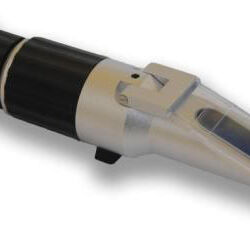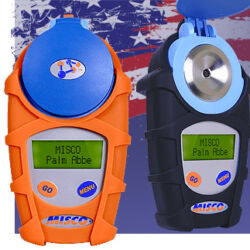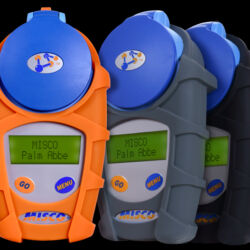What is a Refractometer?
Refractometers are handheld, lightweight, portable instruments used to determine the concentration of water soluble fluids such as machine tool coolants, heat treating fluids, hydraulic fluids, plating baths, detergents, antifreeze, battery acid, etc. The BRIX scale was actually developed for working with sugar related liquids (fruit juices, soft drinks, wine), but it is also commonly used for controlling the concentration of various industrial fluids (cutting coolants, glycol solutions, and flux rinsing compounds).
Refractometers are very easy to use, even the non-digital, analog refractometers. Just place a few drops of fluid on the prism and hold the unit up to a light source. Look into the eyepiece and read the scale. To calibrate, just make sure the prism is clean and place a few drops of tap water on the prism. The separation line should be on zero. If not, turn the adjustment screw until it is.
Remember, refractometers read on a Brix scale rather than actual percent. To get the actual percent, you must multiply the refractometer reading by your coolant’s refractive index (on product data sheet). With most soluble oils the index is 1, so a refractometer reading of 5 multiplied by an index of 1 = 5% concentration. However, many semi-synthetics, synthetics, grinding fluids, and some soluble oils can have a refractive index from 1.5 to 3. So a refractometer reading of 5 multiplied by an index of 1.75 = 8.75% concentration. This is most critical with solutions designed to be run at lower concentrations which have high indexes.
Another often ignored but very important factor is the difference between “working” concentration and “make-up” concentration. The fluid in your tank is the working solution and should be at the recommended concentration. But when adding make-up fluid to the tank, you must allow for evaporation of the water over time from the working solution. Typically the make up should be added at 1/2 the recommended “working” concentration. But there are many variables which affect this relationship, and every machine in the shop will be different. So the best course of action is to monitor the fluid in the tank with a refractometer and adjust the make up fluid leaner or richer to maintain proper working concentration in the tank.
Maintaining the proper concentration of your cutting and grinding fluids can save you money! First, you’ll eliminate “rich” solutions that waste coolant, leave sticky/oily residues, and possibly cause operator health problems. Second, by eliminating “lean” solutions, you’ll extend tool life, limit biological growth, and reduce machine and parts corrosion problems.



